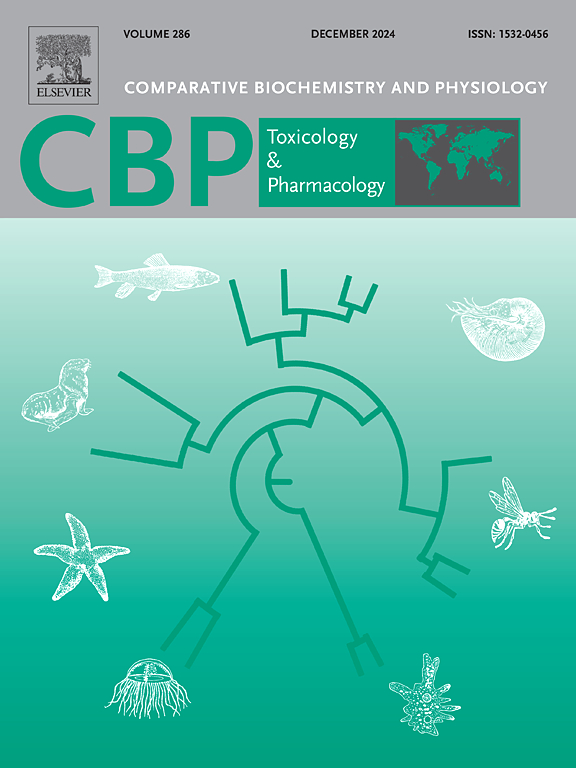From metabolism to lifespan trade-offs: polyethylene microplastics induce circadian disruption and sex-specific aging in Drosophila melanogaster
IF 3.9
3区 环境科学与生态学
Q2 BIOCHEMISTRY & MOLECULAR BIOLOGY
Comparative Biochemistry and Physiology C-toxicology & Pharmacology
Pub Date : 2025-04-27
DOI:10.1016/j.cbpc.2025.110214
引用次数: 0
Abstract
Microplastics (MPs), particularly polyethylene microplastics (PE-MPs), are increasingly recognized as contaminants in both aquatic and terrestrial environments. However, the ecological impacts of PE-MPs on terrestrial organisms remain underexplored. This study investigates the physiological and behavioral effects of PE-MPs exposure in the terrestrial model organism Drosophila melanogaster, shedding light on the potential risks posed by PE-MPs in land-based ecosystems. After exposing the fruit flies to different concentrations of PE-MPs for 20 days, we assessed several physiological biomarkers, including spontaneous behavioral activity, starvation resistance, metabolic biomarkers, and lifespan. Our findings indicate that PE-MPs exposure significantly affects fruit fly physiology, with increased spontaneous activity, decreased starvation resistance, and reduced triglyceride (TG) and protein levels (in males), reflecting disruption of metabolic processes. While PE-MPs did not affect female reproductive capacity, they did result in sex-specific impacts on lifespan, with male fruit flies showing a significant reduction in both mean and median lifespan at higher PE-MPs concentrations. These results highlight the need to consider the sex-dependent nature of PE-MPs toxicity when assessing their ecological risks. This study contributes new insights into the potential for PE-MPs to disrupt terrestrial ecosystems and underscores the importance of investigating the effects of microplastics on terrestrial invertebrates, providing a foundation for future ecotoxicological research.

从新陈代谢到寿命权衡:聚乙烯微塑料诱导黑腹果蝇的昼夜节律中断和性别特异性衰老
微塑料(MPs),特别是聚乙烯微塑料(PE-MPs),越来越被认为是水生和陆地环境中的污染物。然而,PE-MPs对陆生生物的生态影响仍未得到充分研究。本研究探讨了PE-MPs暴露对陆生模式生物黑腹果蝇的生理和行为影响,揭示了PE-MPs对陆生生态系统的潜在风险。将果蝇暴露在不同浓度的PE-MPs中20天后,我们评估了几种生理生物标志物,包括自发行为活动、饥饿抗性、代谢生物标志物和寿命。我们的研究结果表明,PE-MPs暴露会显著影响果蝇的生理机能,增加自发活动,降低饥饿抵抗力,降低甘油三酯(TG)和蛋白质水平(雄性),反映代谢过程的破坏。虽然PE-MPs不会影响雌性的生殖能力,但它们确实会对寿命产生性别特异性的影响,在较高PE-MPs浓度下,雄性果蝇的平均寿命和中位数寿命都显着缩短。这些结果强调,在评估PE-MPs的生态风险时,需要考虑其毒性的性别依赖性。该研究为PE-MPs破坏陆地生态系统的可能性提供了新的见解,并强调了研究微塑料对陆地无脊椎动物的影响的重要性,为未来的生态毒理学研究提供了基础。
本文章由计算机程序翻译,如有差异,请以英文原文为准。
求助全文
约1分钟内获得全文
求助全文
来源期刊
CiteScore
7.50
自引率
5.10%
发文量
206
审稿时长
30 days
期刊介绍:
Part C: Toxicology and Pharmacology. This journal is concerned with chemical and drug action at different levels of organization, biotransformation of xenobiotics, mechanisms of toxicity, including reactive oxygen species and carcinogenesis, endocrine disruptors, natural products chemistry, and signal transduction with a molecular approach to these fields.

 求助内容:
求助内容: 应助结果提醒方式:
应助结果提醒方式:


